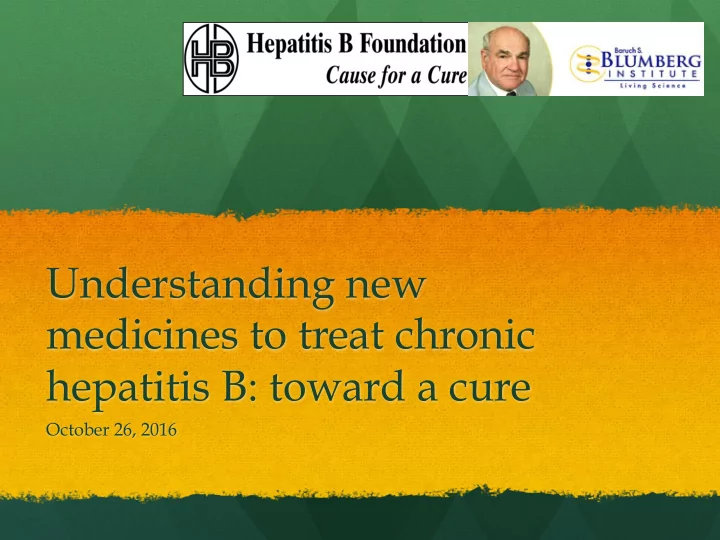

Understanding new medicines to treat chronic hepatitis B: toward a cure October 26, 2016
Define an HBV cure Functionally (practical): Sustained, off drug response (loss of viremia and antigenemia Clinically: Return an individual to the risk of death and disease due to liver disease to that of an age and gender adjusted uninfected individual Block, Gish et al, AVR, 2015 Liang, Block et al, Hepatology, 2016
Categories of HBV therapeutics Indirect (Host) Acting Antivirals (Host Direct Acting Antivirals (DAA) Ryu, W-S (2015)
Timeline of Approved Drugs for Chronic HBV REVEAL Study: The Relationship Between Virus Number and Hepatocirrhosis/Hepatocellular Carcinoma 4006 Study: antiviral therapy could slow down the development of CHB 2002 1998 2004 2005 2006 2007 2008 1992 Lamivudine Entecavir Tenofovir Adefovir Interferon approved for Telbivudine PEG-IFN CHB Tenofovir approved in US for HBV, in 2008, but not yet approved in China for HBV All are Direct Acting Antivirals (DAA)
Functional cures do occur with current therapeutics, although rarely
Failure to cure with NUCs is because
Nests of infected cells (cccDNA containing) remain; HBsAg continues to be made: T cells exhausted B cells: no detectable HBsAb T cells (exhausted) B cells (No detectable Antibody to HBs)
Need Something new that complements current compounds • Different mechanism DAA + • An immuno-enhancer
Categories of Anti-HBV Strategies In-Direct Acting Antivirals Direct Acting Antivirals In Use Immuno-modulatory Essential host functions In Use In Use • • Polymerase – Interferons – None for HBV Potential Potential Potential • • – Therapeutic vaccines – Epigentic modifiers RNaseH – PD-1 blockade – Entry RNAi – Toll R agonists – Morphogenesis Capsid – STING, other innate – Exit inhibitors defense – Glycan processing – Interleukins, other sAg cytokines eAg Virus attachment CRISPR/CAS
The HBV Therapeutic Development Landscape as of Jan, 2016 Pre-clinical Human Phase Trials GS734 0 Pro- Isis HBV ARC52 ten AGX1009 antisense 0 RNAi prodrug GLS-4 TTP MycB DA capsid sAg CMX157 NVR12 entry* A prodrug 21 Benza RNase DVR capsid capsid H inhib capsid ? RepA9 CpAM ALN- Bay41109 sAg capsid S HBV TKM- capsid cccDN ddRNA HBV A iHBV forma Brinipri NV100 Indirect nt Host modifier Editope SMAC Roche HDAC 7795 GS4774 GS9620 Altrava Chimgen vac Toll x HBV e HBV Indirect DV501 Inovio Vac Immunomodulator HBV STING *HDV active
Entry Heptera Immuno Gilead, Arbutus, Roche,Inovio, Akshaya, Springbank Morph Neurovive, Cyclophilin cccDNA Pol Novartis, Gilead, Contravir RNAi Arbutus Alnylam, Arbutus, Arrowhead, IsisBenetec Capsid Arbutis, Gilead, Roche, Novera, Assembly, Jansen Block & Liang, 2016
Pol inhibitors: Currently Available Ten ADF LAM ETV TEL (FMAU in Korea) In development: TAF CMA157
Pol inhibitors: Currently Available Ten ADF LAM ETV TEL (FMAU in Korea) In development: Gilead: TAF Contravir: CMA157 Arbutus (RNaseH inhibit)
cccDNA: “natural” source of all viral gene products
cccDNA: natural source of all viral gene products cccDNA
Repress cccDNA, and repress all natural gene products cccDNA
But cccDNA is a small, tough target Nassal et al, Gut 2015 from Gut
IFN- α LT- β TNF- α IFN- γ HBV NTCP APOBEC3A and/o 3B APOBEC ISGs IFN-induced Biologicals ” 3A/B Antiviral Proteins Approved: Capsid Protein cccDNA IFNs Uracil-DNA Transcription Glycosylase New: U Immunenhancers : U Inovia, Gilead: Thera vaccines AP HBV mRNAs Pol Endonucleases Gilead, Roche: Toll R Capsid Arbutus: STING Envelop Nucleus MVB Other: Arbutus (ARB) Cytoplasm Intellia: CRISPR CAS pgRNA- containing capsids (-) DNA (+/-) DNA Block & Guo, 2015, Gastroeneterology
But some HBV DNA is “integrated” and not free cccDNA, and thus might be missed by drugs acting on cccDNA “free” cccDNA cccDNA “integrated” in to the host chromosomes
RNAi transcript inhibition In development: Antisense: (Ionis/GSK3228836)* shRNA: Alnylam (ALNHBV)* Arrowhead (ARC520,521)* Arbutus (ARB 1467,1740)* Benitec *Human Trials
RNAi / sh RNA leads to degradation of HBV RNA transcripts from cccDNA and integrated DNA
RNAi: Complete shut down: integrated and cccDNA cccDNA
Entry Inhibitors Entry Inhibitor (oilgopeptide) MyrcludexB* Human Trials Liang, Block et al 2016
Entry Inhibitors
Capsid inhibition Capsid Inhibitors Novira NVR 778* Arbutus ARB423 Sunshine* Assembly ABI H101 *Human trials
sAg inhibition sAg Inhibitor Replicor Rep2165* Arbutus ARB Roche* *Human Trials sAg sAg sAg sAg
sAg inhibition: antiviral, anti-antigenemic, and ?immuno restoration sAg sAg sAg sAg
Hepatitis Delta Virus Needs co-infecetion with HBV Mycludex B and Eiger’s Lornafarnib in human trials for HDV
Adaptive & Innate host Adaptive defense Gilead GS4774* Inovio Roche INO1800* Altimmune* Transgene TG1050* Innate T cells Gilead Toll GS9620* (exhausted) Roche Toll RO6884018* SpringBank RIGI SB9200* B cells (No Arbutus STING A detectable Contravir Cyclophil CPI421 Indirect treatment Antibody to HBs) *Human Trials hepatocyte-derived cells Two cell chamber transfer HBV HBV Awaken, stimulate RAW 264.7 cells
Inhibiting the virus life cycle at any step should be equal in eliminating infection Break HBV down in to at least 12 different “assayable”, “targetable” steps Grouped in to 6, here… Entry/ Capsid uncoating assembly Innate host Indirect treatment hepatocyte-derived cells Two cell chamber transfer HBV HBV cccDNA cccDNA formation transcript RAW 264.7 cells Selective elimination Pol/RT inhibitors morphoge nesis
Current Guidelines Rx Rec vary Rx recommended Rx Rec varies
Hepatitis B Foundation Goal No one will die from HBV by 2030 A cure is possible, necessary, and expected
Recommend
More recommend